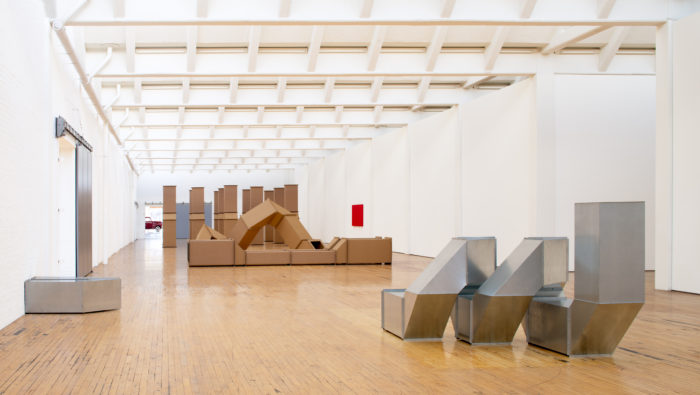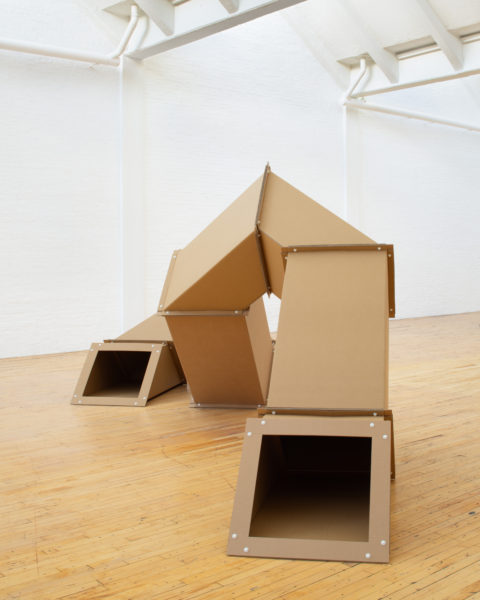
The German minimalist sculptor Charlotte Posenenske was active for roughly a decade, from 1959 to 1968, when she returned to study sociology. She also died young, in her mid-fifties. But as her retrospective at the Dia Beacon points out, her sophistication and willingness to experiment—sometimes in the form of sculptures with moveable components—made her an accomplished artist in a field that was dominated by New York artists. Two major attributes characterize her work: the need to animate simple forms by creating a narrative based on the viewer’s physical interaction with them, and the necessity of accepting art as idea-based, although indebted to a modernism it implicitly critiques. It’s often been said that the quality of writing done in response to ABC art is outstanding; this may be the result of writers feeling the need to justify so little with arguments of high sophistication. Whatever the reasons for the high achievements of this critical literature, its consequences have established a permanent place for an art that has, over time, produced achievements more erratic than previously acknowledged. There will be more than enough time to debate this point.

Posenenske’s art connects as much with industrial systems and architectural supports as with forms stripped to a bare necessity. Working with steel, aluminum, and cardboard, the artist manifests a high intelligence in her execution of self-sufficient forms that mechanize through air ducts, doors enclosing tight spaces, and so on. Her wall reliefs often consist of three curved pieces painted with a single color hung vertically. The two large, long spaces at Dia Beacon give Posenenske’s art an ample chance to display identical components that standstill in space, inviting interaction from the audience. Vierkantrohre Serie DW (Square Tube Series DW) (1967-2018) is a sculpture of a snake-like figure, rising in off the floor by its middle, held together by white plastic screws. It couldn’t be more simple or more manufactured in its presentation, yet the piece holds our interest by virtue of its overall gestalt and its construction by means of near-identical units. Her sculptures can be sharply contrasted with her early, highly expressive paintings on paper. Although, later drawings also manifest Posenenske’s strong interest in repetitive configurations, altered slightly from one image to the next.

Reliefs Serie C (Reliefs Series C) (1967) are two sets of four yellow metal panels, each angling off the wall. The sculpture on the left that faces the viewer consists of yellow planes with a thin amount of space separating one panel from the other. The bottom part of the set rises upward from the ground, while the top two panels drop from the wall to meet the lower components several inches away from the wall support. The right sculpture features top and bottom elements that both move away from the wall–this piece is placed higher up than the work on the left—so that each of the four panels is being pushed away from the facade that holds them as they move outward. The two sculptures’ relentless simplicity emphasizes the works’ similar characteristics: the angle of the planes, the crossed space separating all four of the panels, the bright yellow color of both pieces. There is also a group of tallish, regularly-spaced columns that look very much like a phalanx of warriors, albeit a group of them distinguished by their industrial impersonalities. The orderly rows of the formation suggest a bit of measure in a world that does not easily accept such an outlook.


One of the most playful pieces is a low, gray plane of metal, some twenty feet long and three to four feet high, that viewers can easily move by hand. By moving the long plane of gray, the viewer becomes part of the sculpture himself. This means that Posenenske’s art is not only democratic in its radical simplicity, but also democratic in its necessity of activation—by anyone around. Minimal art is well known for its radicalism; many of the movement’s artists were outspoken against the Vietnam War. A formal radicalism can be seen in Ponsenenske’s art too, which rejects rarification for a utility of design that is meant to connect with as many people as possible—despite the fact that the work offers little that is traditionally seductive in a visual sense, which we assume would limit its audience. Perhaps, the artist is saying that it is more effective artistically to be useful than to be beautiful. Then, too, the inexorable simplicity of Posenenske’s work is not without its innate attractiveness. Fine art is art after all, not industrial design. Ponsenenske was working in an isolated fashion, but that did not stop her from achieving a body of work in which the idea is as attractive as the form it generates—hence our appreciation for this underknown, but excellent artist.
Jonathan Goodman
